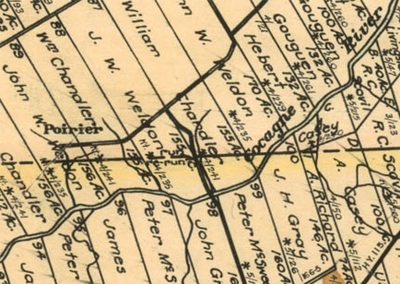Poirier Office
The historical village of Poirier Office dates to the late 1870s with the arrival of Thomas Poirier, from Grand’Digue. Soon, new settlers arrived, Jules M. Goguen, Fidèle Babineau, Damien LeBlanc et Jude Th. Babineau. Residents loved living in Poirier Office. Its covered bridge is still accessible today and one can drive over it and make a wish! Once on the other side, back roads such as Grady Road reach Alexandrina Nor-ouest, Notre-Dame, Saint-Antoine and Trafalgar. Poirier Office is a sheltered and peaceful settlement, surrounded by beautiful nature. It was also known as “Village des étoiles”.
Abt 1850
Martin Grady settled inland at Hays and Alexandrina, closer to Poirier Office. We know that he was the owner before the first inhabitants settled in Poirier Office in 1876. Today, this small road is shown on detailed rural road maps under the name “Graddey Road”. However, local people know better and call it correctly and by the correct name “Grady Road”. This is located from Rive Road which begins where Poirier Office Road ends. The area included a covered bridge that crossed a branch of the Cocagne River. After years of neglect and misuse, the bridge collapsed. Grady Road continues as a trail that leads to Hays and then into the heart of the village.
According to New Brunswick vital statistics, Martin Grady was born around 1830 in Waterford, Ireland. He was married to Mathilda Warren. He was a Roman Catholic and died on August 12, 1900 at the age of seventy in Notre-Dame. Their son, John Edgar Grady, married Mary Julia Murphy on August 25, 1896.
Another member of the Grady family was Amy or Annie Grady, born in Ireland around 1828. She died in Notre Dame on July 17, 1895. Records indicate that an Annie Grady of Notre Dame and probably the sister of John Edgar, died in Boston on July 28, 1906 at the age of forty-two; so she would have been born around 1864. Another interesting detail on John Edgar’s death certificate shows Mrs. A. J. Bagnell of Notre Dame as his sister.
1876
Thomas Poirier first settled Village des Poirier/Poirier Office. Soon afterwards, Jude Goguen, Fidèle Babineau, Damien LeBlanc, and Jude Babineau also settle there.
after 1876
A bridge was built at Village des Poirier/Poirier Office; it becomes fondly known as “pont des étoiles” or bridge of stars.
1884 to 1956
A post office operated in Poirier Office (Village des Poiriers). Postmaster Jules Goguen is followed by Edmond Babineau.
1893
In July, Guilford P. Goguen paid Joachim P. Goguen $1.20 for 2 lbs of tobacco according to a worker’s diary.
1893
Work records showed Charles Noel, Maxime Gallant, David Chapman, and Philip A. Goguen as having worked on the bridge over the Cocagne River in Notre-Dame.
1894
On May 30, 1894, Philip Goguen exchanged $4.25 worth of potatoes and bought two sheep from Maximin Babineau for $2.50 as noted in a record of household affairs.
1895
On June 10, 1895, Maximin Babineau bought one pair of oxen for $40 as noted in a record of household affairs.
1896
In June 1896, Edward White hired several men to work: Fred Barnes, Thomas Scott, John Cochran, Silvain Goguen, Maxime Goguen, and Philip A. Goguen.
1896
On August 25, 1896, John Edgar Grady (son of Martin Grady and Mathilda Warren) married Mary Julia Murphy of South Branch, NB. He was twenty-eight years old and she was twenty-five years old. Margaret Grady of Notre Dame and Luke Murphy of South Branch, NB were the witnesses. According to vital statistics, Grady was a farmer who lived in Notre Dame.
Mary Julia was the daughter of Thomas Murphy of Wexford, Ireland and Mary Ryan also from Ireland. She was born on April 14, 1867 and died on September 18, 1938 at the age of seventy-one. John Edgar was born on January 6, 1869 and died on September 29, 1943 in Fairville (Saint John) NB at the age of seventy-four. They are both buried in the Notre-Dame Catholic cemetery.
Sara Grady was another member of the Grady family. She was married to John Carroll and their children were:
Catherine Melinda Carroll (born June 23, 1888 in Cocagne). Marguerite (born August 15, 1890), Martin Thomas (born September 29, 1892 in Dundas) and Notre-Dame born John William (born December 10, 1894), Sara Helen (born February 28, 1897), Joseph Earl (born February 22, 1898), Miriam Violet Mary Lilian (born July 12, 1900), Dora Cecilia A. (born July 10, 1902), Felix Ray (born January 6, 1906).
1897
On October 9, 1897, Ferdinand Léger bought 12m of shingles for $12 as noted in a record of household affairs.
1897
A report was published on November 17, 1897 on the Moniteur Acadien about Father Dufour and Thomas Poirier.
1900
One-half ton of hay cost $3.50, one bushel grass seed $2.50, one pair of shoes $1.10, five locks and nobs $1.50, one bottle of Mother Seigel $0.30, one hundred lbs of flour $5, three lbs of tea $1.20, one gallon of oil $0.25, and one bottle of liniment $0.35 according to a record of household affairs.
1901
The Catholic Church was officially named Notre-Dame-du-Sacré-Coeur and the parish subsequently defined the territory of the community of Notre-Dame. The settlements (or historical villages) included were MacDougall Settlement, Poirier Office, LeBlancville, Dufourville, Notre-Dame Centre, Guéguen, Hays, Alexandrina-Nor’ouest, North and South sides of the river, Whites Settlement, and MacDougall Settlement along with Village des Pishcots, Village des Fricots, Suretteville, Teed Road and Chemin des Thaddées.
1901
On March 22, 1901, a powerful freshet took down three covered bridges: the Lockhart Bridge the Poirier Bridge, and the McLaughlin Bridge. It is believed that all bridges were rebuilt.
1901
On June 29, 1901, a bridge was sold to John Colborne for $20. Bridge #2 across Alexandrina (Nor’ouest) stream was sold to Maxime Robichaud for $13.50. Two Poirier Office bridges were sold to Thomas Poirier, one for $12 and the other for $20.
1904
Poirier Office was described as having one post office and a population of 100.
1954/56
A home postal delivery service was introduced in Notre-Dame. Mail was delivered by drivers who would insert letters and parcels in mailboxes next to the road of each house and business throughout the community. One route started at the Notre-Dame Post Office then onward to Hays, Alexandrina-Nor’ouest, across the covered bridges to Poirier Office, LeBlancville, Dufourville and ending where the route began, at the post office. Delivery areas grew to include Guéguen, the South side of the river road. The MacDougall Settlement mail delivery was and remains part of a different route.
With the arrival of mailboxes and home postal delivery, several small post offices were closed, such as Dufourville, LeBlancville, Alexandrina-Nor’ouest, Poirier Office, and MacDougall Settlement.
Postal delivery was first done and for many years by Joe Delaney, followed by Thomas Robichaud, M. Delaney, Olivier Bourque, Alcide Pellerin, Frank Maillet, Regis Bourque, and others.
1959
The school at Village des Poirier/Poirier Office closed and students were transferred to École Centrale de Notre-Dame.
2000
In March, the postal addresses were changed from site and box number to civic numbers thereby improving efficiently and visibility, especially for emergency services such as fire and balance services.


